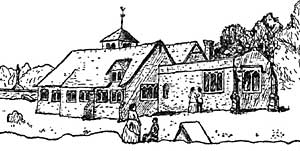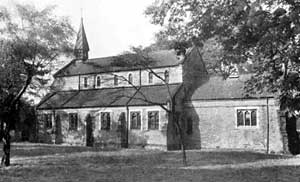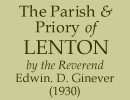< The Dissolution of Lenton Priory | Contents | The monuments in the priory church >
11.—THE PARISH CHURCH OF LENTON.
Although there is no mention of a church at Lenton at the time of the Domesday Survey, such omission must not be taken in itself as proof of the non-existence of a church at that period; but the foundation charter of Lenton Priory is also silent on the same subject, and no specific reference to the Parish Church is to be found previous to the dissolution, although the benefice is mentioned as early as the year 1292 in the Ecclesiastical Taxation of Pope Nicholas the Fourth. A vicar was appointed in 1274 (Robert Anger). It is therefore probable that, previous to the dissolution of Lenton Priory, some portion of the conventual church was set apart for the use of the parishioners. Many of the greater monasteries had churches standing in their closes, or a collateral church. These churches, which were distinct from the conventual church, were at first regarded as mere chapelries, served by a chaplain at an altar, which was considered as being included in the conventual church, as if it stood under the same roof, which was actually the case in some churches.
Although the fact remains to be proved, we may probably infer that a portion of the conventual church at Lenton was used by the parish, its altar being served by the Vicar, who in a limited sense would be independent of the monks. Such an arrangement, though not uncommon in some other orders, is, however, seldom to be found in the Cluniac monasteries.
In the year 1200, the Canons of Westminster forbade a monk to be placed alone in a parish church, and required him to keep within his cloister. In 1268, the Papal Legate imposed a restriction upon the appropriation of churches to any Priory or other monastery, and made an order that all religious houses, exempt and not exempt, Cistercians and others who held such churches, should present a resident Vicar for institution by the diocesan, providing him with a sufficient portion out of the endowment, and a house with a garderobe and chimney after the French fashion. Usually, the dependent Vicar received a "robe of clerical suit" and, as at Lenton, daily rations when near a convent. There was a tradition, subsequently confirmed, to the effect that after the dissolution of the Priory, the chapel, or some portion of the Hospital of S. Anthony, which formerly stood in the courtyard of the Priory, was converted into the Parish Church.
[S. Anthony was born at Coma in Upper Egypt in 281 A.D. (died 356). He was the Patriarch of the monks of Egypt. A man of good family and wealth, he went from Alexandria into the Thebaic!, and organised the scattered companies of recluses into a community dwelling in separate cells, but bound by the uniform vow of chastity, poverty, and manual labour for the common good.]
Within the courtyard of the Priory had stood a hospital, "for the free and charitable sustentation of such as should be troubled with S. Anthony's fire" (erysipelas). Here, "strangely visited people, all swoln and ulcerous, pitiful to the eye, the mere despair of surgery," received that surgical treatment for which many of the monasteries were famous.
It is somewhat remarkable that, with the exception of the following certificate of church goods taken in the year 1552, no particulars relative to the church in the 16th or 17th centuries have been met with, neither are there any notes of old monuments or stained glass. The certificate of church goods belonging to the parish of Lenton is dated Sept. 5th, 6 Edward VI (1552), and is as follows: —
"ffyrst. one sanctus bell.
it. ij vestments of whyte ffustyan.
it. one vestment of dornyxe.
it. one albe.
it. one chalyse with a patene of sylvr.
it. one cowpe of red sey. (Silk and wool mixed).
it. ij belles, " the one callyd a hande bell and the other a sacryng
bell."
The certificate is signed by,
Robert Gaybone—Vicar |
||
Antony Weston |
|
|
John Lecestr |
|
p'shioners |
Avery Walker. |
|
|
John Bowser, |
|
Ch. wardens.. |
12.—THE PRIORY CHURCH (HOLY TRINITY AND THE CHAPEL OF S. ANTHONY).
The tradition that the present Priory Church is built upon the site of the chapel of the Hospital of S. Anthony, which stood within the precincts of the monastery, was more than confirmed during the building operations in 1884; it was then discovered that the walls of the present chancel arc actually the walls of the ancient chapel. The piscina niche in situ was disclosed, and the discarded foundations of the chapel were uncovered. It seems therefore clear that a parish church was evolved, dedicated to the Holy Trinity, by building a new and wider nave to the older chapel of S. Anthony. The level of the chancel floor was raised, new windows inserted in the old walls, and a new roof put on. All the new work was done in the Tudor style of architecture, which at that time prevailed. This building served the needs of the parish until 1842, when the new church was built.
Previous to the partial demolition of this building, in 1843, there was a wooden belfry at the west end of the nave. This belfry, or "steeple," as it is called in the parish books, was newly boarded over in 1725 and again in 1764, and contained a bell bearing the inscription "William Ward and Thomas Berene of Lenton 1591." This bell is said to have been broken in a vain attempt to knock a wedding peal out of it by means of hammers. The bell that replaced it in 1820 is now in S. Paul's Church, Hyson Green, originally a chapel-of-ease built on glebe land awarded to the Vicar of Lenton in 1799.
The church had an open timber roof until 1775 when it was ceiled. In 1807 the floor of the church was raised on account of the damp, a vestry erected, the church renewed, and a stove for warming introduced. In 1811 the churchyard wall was rebuilt, and an iron gate fixed therein; and in 1820, trees were planted round, which cost the Wardens 16s.
Archdeacon Eyre visited Lenton in 1811 and prescribed various further restoration to the roof, steeple and walls, pointing and underpinning being necessary. He objected to cattle grazing in the churchyard, as they damaged the graves and stones, and ordered that only sheep were to be allowed in. The steeple was repaired in 1829, and the wall between the churchyard and Old Church Street (then called Churchill Close) and neighbouring garden plots was built of Bulwell Stone in 1841.
 |
The priory church in 1843. |
In 1843 a faculty was obtained to take down this original parish church of Lenton, except the chancel and vestry. The faculty provided for the removal of the monuments from the old church to the new parish church erected at this time, and the transfer of the building material to Ison (Hyson) Green for the erection of a chapel-of-ease there, to which place went the old pulpit and reading desk: for several years the altar rail served the purpose of a fence to the river Leen at the end of Friar Street.
Burials in the churchyard were discontinued on April 1st, 1857, by order of the Privy Council. Divine Service continued to be conducted in the chancel, which was fitted up with plain wooden benches, with the old clerk's desk placed under the east window doing duty for reading desk and pulpit. Here the vestry meetings were held for a long time. There is a story told of the consternation and dismay of some of the ultra-protestant parishioners of the Victorian type, at the inception of Sung Evensong in the chancel of the old church by a Scripture Reader named Robert McKenny. It was declared that such an innovation was nothing short of a Romanising tendency. Much the same antagonism was aroused when the first Vicar of the new church first wore a surplice in which to preach, in place of the usual black gown; and when the boys and girls of the Sunday School were allowed to mix, on the occasions of the anniversary or treat.
So the old church on the Priory site, the first parish church of Lenton, went out of use, and the nave was demolished, the chancel only, after a time, being restored for the uses to which reference has just been made.
At the restoration of the chancel, on removing the plastering from the wall below the three-light window on the south side, a piscina, with a quatrefoil basin (the projecting portion of which was broken off) and drain, was discovered about a foot above the level of the floor. The piscina has been restored and built into the south wall, nearer the east end, at a height of two feet eight inches above the new altar steps. The three-light Tudor window at the east end, as well as the large one on the south side (before mentioned), both of which were removed later, were found to be inserted in the place of older windows which were originally much larger and nearer the floor. The ancient openings were partially filled up with masonry at the time the more modern windows were put in. On the north side, a small priest's doorway, blocked with masonry, was disclosed. This doorway was two feet nine inches wide, and five feet two inches from the level of the floor to the crown of the depressed arch which formed the head. The prevailing colour of the ancient fresco work was a deep chocolate red. The floor level, as has been remarked, was the level of the chancel floor previous to the last restoration, in 1883, when the pavement was raised 18 inches. But during this restoration the ancient floor was discovered at a depth of 5 feet 1 inch below the present floor level of the chancel. This remarkable difference of floor levels will account for the position of the piscina in the south wall. On the ancient floor a Purbeck coffin lid bearing a slightly raised cross, of 13th century work, was found. This is now placed behind the organ for want of a more convenient place. It is 6 feet, 3 inches long, 22 inches wide at the top, and 14 inches wide at the bottom. A similar one is to be seen in the churchyard, but it has no trace of carving.
The two blocks of stone which form part of the present altar step were found at the same time. These stones appear to have formed originally one stone 9 feet 6 inches long, and 6 inches thick, the original use of which is uncertain.
In July of the year 1843, the foundation stone of the chapel-of-ease at Ison (Hyson) Green was laid, and removals were made, which included the bell and the reading desk. Thus matters stood until 1883. On the 22nd of November of that year, building operations were resumed, due almost entirely to the efforts of the Rev. Percy Edward Smith, the Curate of Lenton. The old church was again restored, new windows inserted in the old walls, and a new nave and aisles built; and the old church, which is now known as the Priory Church, was brought again into regular use as a chapel-of-ease. The mother church has thus become a daughter church while still occupying the monastery site.
 |
The priory church (exterior). |
In spite of these vicissitudes some slight traces of old work remain. The three crowns on the dexter shield over the west door are the emblem of S. Ethelred, King and Martyr, and the three double fleur-de-lys on the sinister shield are the emblem of S. Thomas of Hereford. The small window on the south side of the chancel is the old "Low-side" window of S. Anthony's chapel, the use of which is a subject of much controversy. On the south-east buttress there is an ancient scratch dial, almost undistinguishable now, while under the south-west window there is a slab, inscribed with the shaft of a cross, a missal and a chalice, probably from the grave of a former vicar of Lenton. Laird, who wrote in 1814, before the church was dismantled, and who seems to have derived much of his information relative to this place from Mr. William Stretton, mentions an ancient monumental stone, near the reading desk, on which a cross and chalice were carved with the date 1333. This was perhaps the same slab as the one just referred to, although there is no indication of any inscription on the part that remains.
Reference has already been made to the altar step, on which there is some Norman carving, to the piscina niche and to the coffin lid behind the organ. Apart from these, the existing fabric is of comparatively little interest in itself, and consists merely of a nave, measuring externally about 42 feet by 36 feet, and the chancel, measuring about 28 feet by 18 feet, having on the north side a small vestry of modern construction. The doorway to the vestry, from the chancel, appears to be partly formed out of an ancient window, 3 feet 4 inches wide and 6 feet high, the distance from the sill to the floor level being 2 feet 6 inches. Between this ancient window and the east wall, and above the new aumbry (which does not replace an older one), traces of black letter inscriptions and various ornamentations were found on removing the plaster.
The memorial stone of the present Priory Church was laid by the Lady of the Manor, Mrs. Sherwin Gregory. The stone forms the base of the pillar at the east end of the north aisle, and bears the following inscription: —
"To the Glory of God this stone was laid by Mrs. J. Sherwin Gregory, and consecrated by Christopher, Bishop of Lincoln, November 22nd, 1883."
The Bishop, previous to the ceremony, preached a sermon in the new parish church. The Duke of S. Alban's, the Mayor of Nottingham, the Sheriff, the Rev. Canon Morse, Vicar of S. Mary's, and a large number of clergy were in attendance. The Vicar of Lenton (The Rev. Geo. Browne) was unable to be present, and he was represented by his curate, the Rev. Percy E. Smith.
The Priory Church, which was previously the Church of the Holy and Undivided Trinity, is now known officially as S. Anthony's Church, but commonly as the Priory Church.
The Priory Church has its acting wardens and representatives on the Parish Council.
< The Dissolution of Lenton Priory | Contents | The monuments in the priory church >
